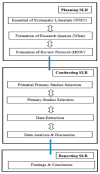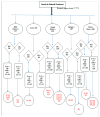A Comparative Systematic Literature Review on Knee Bone Reports from MRI, X-rays and CT Scans Using Deep Learning and Machine Learning Methodologies
- PMID: 32722605
- PMCID: PMC7460189
- DOI: 10.3390/diagnostics10080518
A Comparative Systematic Literature Review on Knee Bone Reports from MRI, X-rays and CT Scans Using Deep Learning and Machine Learning Methodologies
Abstract
The purpose of this research was to provide a "systematic literature review" of knee bone reports that are obtained by MRI, CT scans, and X-rays by using deep learning and machine learning techniques by comparing different approaches-to perform a comprehensive study on the deep learning and machine learning methodologies to diagnose knee bone diseases by detecting symptoms from X-ray, CT scan, and MRI images. This study will help those researchers who want to conduct research in the knee bone field. A comparative systematic literature review was conducted for the accomplishment of our work. A total of 32 papers were reviewed in this research. Six papers consist of X-rays of knee bone with deep learning methodologies, five papers cover the MRI of knee bone using deep learning approaches, and another five papers cover CT scans of knee bone with deep learning techniques. Another 16 papers cover the machine learning techniques for evaluating CT scans, X-rays, and MRIs of knee bone. This research compares the deep learning methodologies for CT scan, MRI, and X-ray reports on knee bone, comparing the accuracy of each technique, which can be used for future development. In the future, this research will be enhanced by comparing X-ray, CT-scan, and MRI reports of knee bone with information retrieval and big data techniques. The results show that deep learning techniques are best for X-ray, MRI, and CT scan images of the knee bone to diagnose diseases.
Keywords: computed tomography (CT scan); electromagnetic radiation (X-ray); magnetic resonance imaging (MRI); trabecular bone (TB).
Conflict of interest statement
The authors declare no conflict of interest.
Figures
References
-
- Ryzhkov M.D. Master’s Thesis. Utrecht University; Utrecht, The Netherlands: 2015. Knee Cartilage Segmentation Algorithms: A Critical Literature Review.
-
- Senaras C., Gurcan M.N. Deep learning for medical image analysis. J. Pathol. Inform. 2018;9:25.
-
- Kim D., Lee J., Yoon J.S., Lee K.J., Won K. Development of automated 3D knee bone segmentation with inhomogeneity correction for deformable approach in magnetic resonance imaging; Proceedings of the 2018 Conference on Research in Adaptive and Convergent Systems; Honolulu, HI, USA. 9–12 October 2018; pp. 285–290.
Publication types
LinkOut - more resources
Full Text Sources






